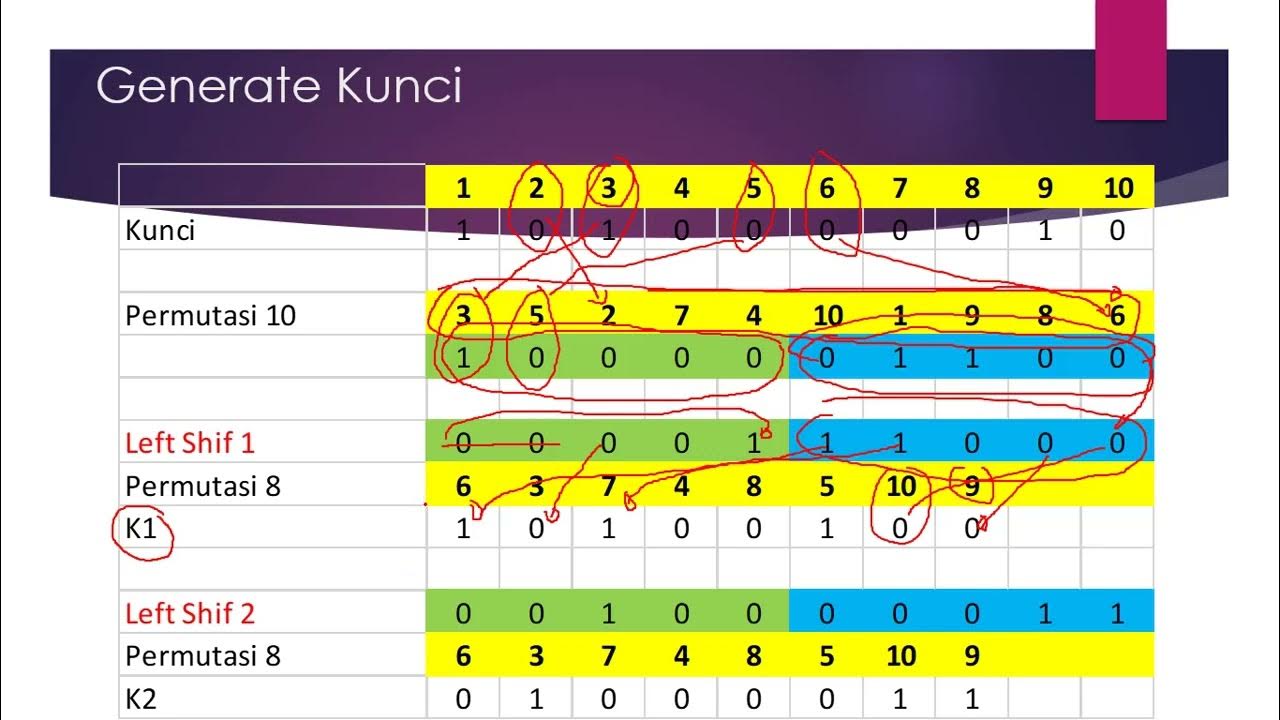What is a stream cipher and how does it work?
Summary
TLDRA stream cipher is a symmetric key encryption method where each bit of the plaintext is combined with a corresponding bit from a keystream, typically using an XOR operation. The keystream is generated from a secret key and a random seed value. Stream ciphers are of two types: synchronous, where the keystream is independent of the plaintext or ciphertext, and self-synchronizing, where the keystream depends on previous ciphertext bits. Stream ciphers are favored in applications where the length of the plaintext is unknown, such as secure wireless communications, due to their speed and simplicity in hardware implementation.
Takeaways
- 😀 A stream cipher is a symmetric key cipher used for encryption and decryption using the same secret key.
- 😀 In a stream cipher, plaintext is combined with a keystream, typically bit by bit, to generate ciphertext.
- 😀 The keystream in a stream cipher is generated from a pseudo-random number generator (PRNG) seeded with a random seed value.
- 😀 Decryption in a stream cipher follows the same process as encryption, where the ciphertext is XORed with the generated keystream to recover the plaintext.
- 😀 Stream ciphers are typically faster and simpler to implement in hardware compared to block ciphers.
- 😀 There are two types of stream ciphers: synchronous and self-synchronizing (asynchronous).
- 😀 In a synchronous stream cipher, the keystream is generated independently of the plaintext and ciphertext.
- 😀 In a self-synchronizing stream cipher, the keystream is generated based on both the cipher key and a fixed number of previous ciphertext digits.
- 😀 Stream ciphers are preferred in applications where the length of the plaintext is unknown, such as secure wireless communication.
- 😀 A stream cipher is particularly useful in situations where data length cannot be determined in advance, like real-time secure communications.
- 😀 For more detailed information on stream ciphers, viewers are encouraged to refer to books on cryptography and public key infrastructure or visit the relevant security websites.
Q & A
What is the purpose of encryption in communication?
-Encryption ensures that a sensitive message sent by a sender can only be read by the intended recipient, preventing third parties from intercepting and reading the message.
What is symmetric key encryption?
-Symmetric key encryption uses the same secret key for both encrypting and decrypting the message, meaning the sender and the recipient share a common key.
How does public key encryption differ from symmetric key encryption?
-In public key encryption, two different keys are used: one for encryption and a different one for decryption. In contrast, symmetric key encryption uses a single key for both processes.
What is a stream cipher?
-A stream cipher is a symmetric key cipher that encrypts plaintext one bit at a time by combining it with a keystream, which is generated from a secret symmetric key.
How is a stream cipher different from a block cipher?
-A stream cipher operates on individual bits of plaintext, whereas a block cipher encrypts data in fixed-size blocks, usually larger than a single bit.
What role does the keystream play in a stream cipher?
-The keystream is a pseudorandom sequence of digits generated from the secret key. Each bit of plaintext is combined with the corresponding bit of the keystream to produce ciphertext.
How does the encryption process work in a stream cipher?
-In a stream cipher, the plaintext is XORed with the keystream, generating the ciphertext. Each bit of the plaintext is encrypted with the corresponding bit from the keystream.
What happens during the decryption process in a stream cipher?
-During decryption, the same keystream is regenerated using the same seed value. The ciphertext is XORed with the keystream to recover the original plaintext.
What are the two types of stream ciphers?
-The two types of stream ciphers are synchronous stream ciphers, where the keystream is generated independently of the plaintext and ciphertext, and self-synchronizing (asynchronous) stream ciphers, where the keystream depends on the secret key and previously generated ciphertext digits.
Where are stream ciphers typically used?
-Stream ciphers are often used in applications where the length of the plaintext is unknown, such as in secure wireless connections, due to their speed and efficiency in hardware implementations.
Outlines

هذا القسم متوفر فقط للمشتركين. يرجى الترقية للوصول إلى هذه الميزة.
قم بالترقية الآنMindmap

هذا القسم متوفر فقط للمشتركين. يرجى الترقية للوصول إلى هذه الميزة.
قم بالترقية الآنKeywords

هذا القسم متوفر فقط للمشتركين. يرجى الترقية للوصول إلى هذه الميزة.
قم بالترقية الآنHighlights

هذا القسم متوفر فقط للمشتركين. يرجى الترقية للوصول إلى هذه الميزة.
قم بالترقية الآنTranscripts

هذا القسم متوفر فقط للمشتركين. يرجى الترقية للوصول إلى هذه الميزة.
قم بالترقية الآن5.0 / 5 (0 votes)






